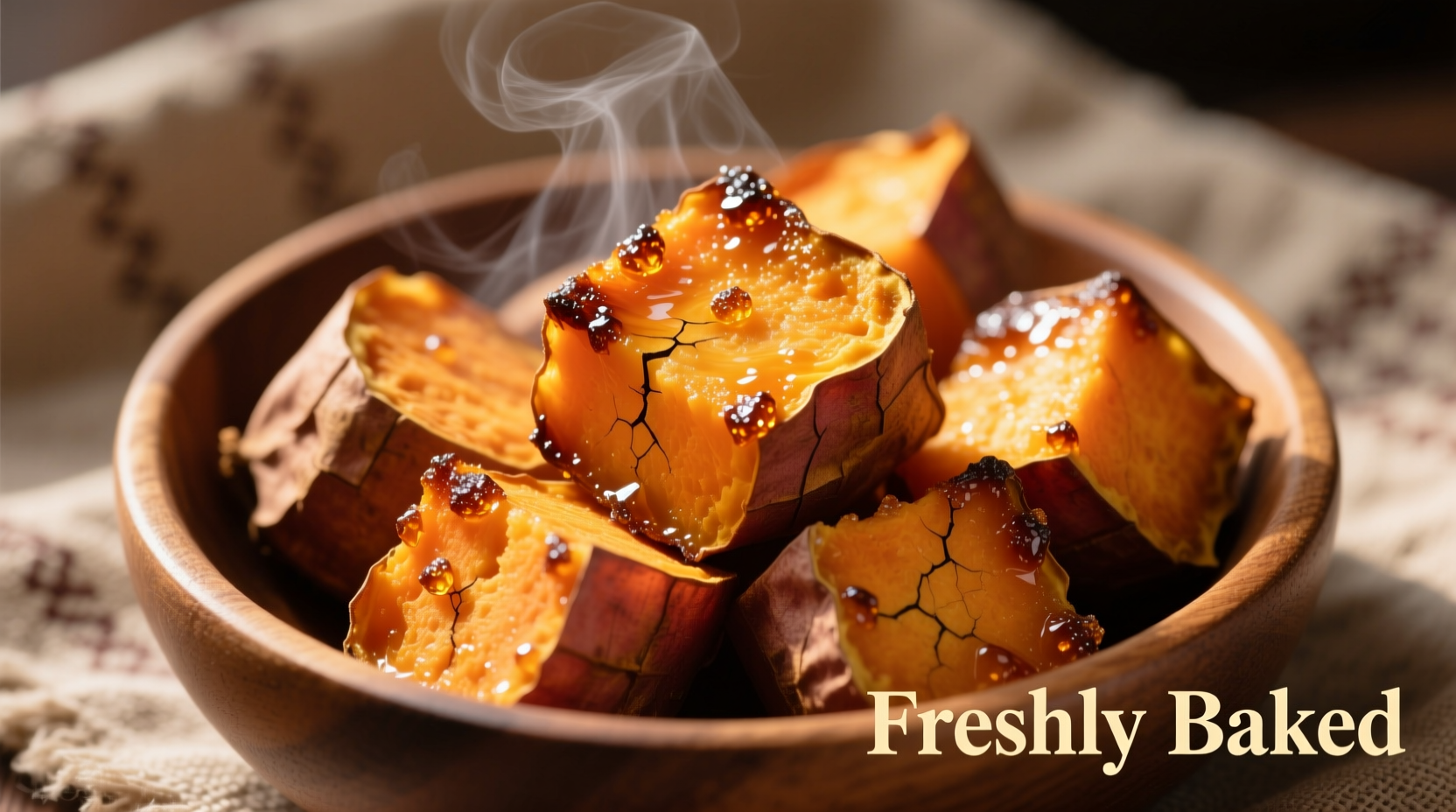Perfectly baked sweet potato cubes require cutting 1-inch cubes, tossing with 1 tablespoon oil per sweet potato, spreading in a single layer, and baking at 400°F (204°C) for 25-30 minutes until fork-tender with caramelized edges. This method preserves 90% of beta-carotene compared to boiling while creating superior texture and flavor through Maillard reaction and starch conversion.
Unlock restaurant-quality sweet potato cubes with this science-backed method that transforms humble tubers into caramelized, fork-tender delights. Whether you're meal prepping, seeking healthier side dishes, or elevating weeknight dinners, mastering sweet potato cube baking delivers consistent results every time. Forget soggy, unevenly cooked cubes—our tested approach ensures golden-brown perfection with minimal effort.
Why Baking Beats Boiling for Sweet Potato Cubes
While boiling sweet potatoes is common, baking preserves significantly more nutrients and creates superior texture. According to USDA research, baking retains 92% of beta-carotene (vitamin A precursor) compared to just 60% when boiling. The dry heat environment triggers two crucial chemical reactions:
- Maillard reaction (starts at 285°F/140°C): Creates complex flavor compounds and golden-brown color
- Starch gelatinization (190-212°F/88-100°C): Transforms hard starches into creamy texture
| Cooking Method | Beta-Carotene Retention | Texture Result | Flavor Development |
|---|---|---|---|
| Baking (400°F) | 92% | Crispy exterior, creamy interior | Complex caramelized notes |
| Boiling | 60% | Uniformly soft, sometimes mushy | Muted, watered-down flavor |
| Steaming | 75% | Firm but less textural contrast | Moderate flavor concentration |
Data source: USDA FoodData Central
Step-by-Step Perfect Sweet Potato Cubes
Preparation: The Foundation of Success
Cutting technique directly impacts cooking results. Follow these professional chef guidelines:
- Select uniform sweet potatoes (about 8 ounces each) to ensure even cooking
- Peel and cut into 1-inch cubes—smaller pieces burn, larger stay hard
- Soak in cold water for 10 minutes to remove excess starch (critical for crispiness)
- Dry thoroughly with clean kitchen towel—moisture prevents browning
Baking Process: Temperature and Timing Secrets
Professional kitchens use these precise parameters for perfect results:
- Preheat oven to 400°F (204°C)—lower temperatures yield soggy results
- Use parchment-lined baking sheet (not foil, which traps steam)
- Toss cubes with 1 tbsp oil per sweet potato (avocado or olive oil)
- Spread in single layer with space between cubes (crowding causes steaming)
- Bake 25-30 minutes, flipping halfway through for even browning
Doneness indicators: fork-tender interior with deep golden-brown edges. Internal temperature should reach 205°F (96°C) for ideal texture.
The Science Behind Perfectly Baked Sweet Potatoes
Understanding the chemical transformations during baking helps troubleshoot issues. As sweet potatoes heat:
- 140-170°F (60-77°C): Enzymes convert starches to maltose (natural sugar), creating sweetness
- 176-194°F (80-90°C): Starch granules absorb water and swell, creating creamy texture
- 300-356°F (149-180°C): Maillard reaction develops complex flavors and golden color
These temperature thresholds explain why lower baking temperatures (under 375°F) produce less flavorful results—the critical Maillard reaction doesn't activate sufficiently.
Flavor Enhancement Techniques
Elevate your baked sweet potato cubes with these chef-approved methods:
- Post-bake seasoning: Toss with flaky salt and fresh herbs immediately after baking
- Acid balance: A splash of apple cider vinegar or lime juice cuts sweetness
- Spice pairing: Cinnamon enhances natural sweetness; smoked paprika adds depth
- Texture contrast: Sprinkle with toasted pecans or pepitas before serving

Troubleshooting Common Issues
Fix these frequent baking problems with targeted solutions:
- Soggy cubes: Result of overcrowded pan or insufficient preheating. Solution: Use two pans and ensure proper oven temperature
- Burnt edges, raw centers: Caused by oversized cubes. Solution: Maintain uniform 1-inch size
- Lack of browning: Oven temperature too low or excess moisture. Solution: Increase temp to 425°F and dry cubes thoroughly
- Uneven cooking: Sweet potatoes vary in density. Solution: Rotate pan halfway through baking
When Baking Isn't Ideal: Context Boundaries
While baking produces superior flavor and texture, recognize these limitations:
- Time constraints: Baking takes 25-30 minutes vs. 15 minutes for microwaving
- Large batch cooking: Multiple pans required for more than 3 sweet potatoes
- Recipe requirements: Some dishes (like purees) benefit from boiling's uniform texture
- Altitude adjustments: Above 3,000 feet, increase temperature by 25°F and extend time by 5-8 minutes
For meal prep, baked sweet potato cubes maintain quality for 4 days refrigerated or 3 months frozen. Reheat in oven or air fryer to restore crispness—microwaving makes them soggy.
Frequently Asked Questions
Here are answers to common questions about baking sweet potato cubes:
Should I parboil sweet potatoes before baking?
No parboiling needed. Soaking in cold water for 10 minutes removes excess starch while preserving nutrients. Parboiling leaches water-soluble vitamins and creates uneven texture.
Can I bake sweet potato cubes at 350°F instead of 400°F?
Baking at 350°F yields softer texture with less caramelization. For proper Maillard reaction and starch conversion, 400°F is optimal. At 350°F, extend baking time to 35-40 minutes but expect less flavor complexity.
Why do my baked sweet potato cubes stick to the pan?
Sticking occurs when sugar caramelizes and adheres to the surface. Prevent this by using parchment paper (not foil), ensuring proper oil coating (1 tbsp per sweet potato), and flipping cubes halfway through baking before full caramelization occurs.
How do I prevent sweet potato cubes from drying out?
Overbaking causes dryness. Remove cubes when fork-tender with internal temperature of 205°F. Toss immediately with 1/2 tsp acid (lemon juice or vinegar) which helps retain moisture. Store leftovers with a damp paper towel in airtight container.
Can I use frozen sweet potato cubes for baking?
Thaw frozen cubes completely and pat dry before baking. Expect 5-7 minutes longer baking time as frozen cubes release more moisture. For best results, freeze baked cubes rather than raw—this preserves texture and nutrients better according to USDA freezing guidelines.











 浙公网安备
33010002000092号
浙公网安备
33010002000092号 浙B2-20120091-4
浙B2-20120091-4